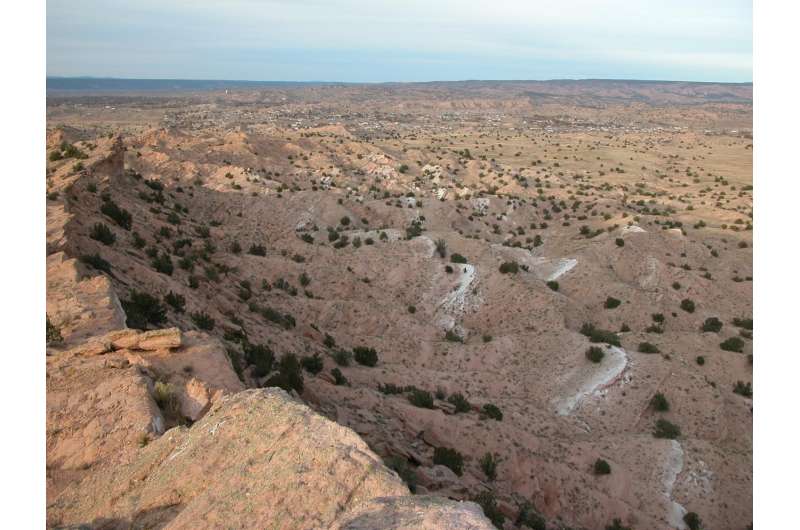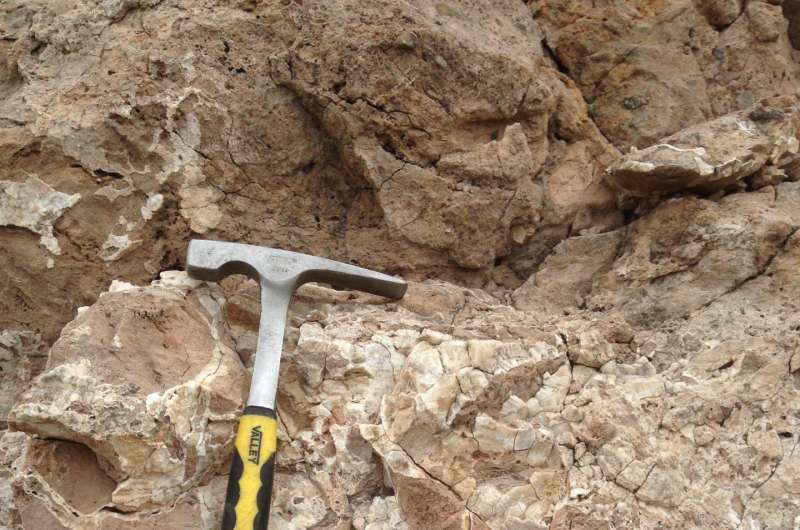April 25, 2017 report
Using coseismic calcite veins to date New Mexico fault line earthquakes back half a million years

(Phys.org)—A team of researchers with the University of Wisconsin, Berkeley and the New Mexico Institute of Mining and Technology has used U-Th testing of coseismic calcite veins at the Loma Blanc fault in New Mexico to learn the earthquake history of the fault going back almost a half-million years. In their paper published in Proceedings of the National Academy of Sciences, the group describes their study and their assembly of the longest seismic record ever made of any fault in the world.
In most cases, it is difficult if not impossible to obtain an earthquake history for long periods of time for most fault lines, but the Loma Blanc fault is different—earthquakes there have left co-seismic calcite veins that offer a means for documenting earthquakes going back approximately 550,000 years. All that was needed was to date the material in the veins (using radioactive isotopes of uranium and thorium) and then to measure the distance between them. After doing so, the researchers report that earthquakes occurred at fairly regular intervals for most of the timeline they built, as was expected, but they also found that for one short period of time approximately 430,000 years ago, there was a cluster of larger-than-normal earthquakes.
After more digging, the researchers found that the cause of the earthquake cluster was sand being forced upward through the rocks below them, which the researchers believe was due to overabundant water in the ground—too much water created extra pressure, which ultimately resulted in a rash of earthquakes. Why there was a period of too much water or flooding in the area is not known, but there was also a larger than normal release of carbon dioxide into the atmosphere. The team notes that the find is the first of its kind discovered to have occurred naturally.

The researchers note that their findings are similar to events happening in modern times due to human activities, such as fracking and other operations that involve forcing water underground—the end result is unnatural earthquakes occurring out of sync with a fault's natural cycle.
More information: Randolph T. Williams et al. Reading a 400,000-year record of earthquake frequency for an intraplate fault, Proceedings of the National Academy of Sciences (2017). DOI: 10.1073/pnas.1617945114
Abstract
Our understanding of the frequency of large earthquakes at timescales longer than instrumental and historical records is based mostly on paleoseismic studies of fast-moving plate-boundary faults. Similar study of intraplate faults has been limited until now, because intraplate earthquake recurrence intervals are generally long (10s to 100s of thousands of years) relative to conventional paleoseismic records determined by trenching. Long-term variations in the earthquake recurrence intervals of intraplate faults therefore are poorly understood. Longer paleoseismic records for intraplate faults are required both to better quantify their earthquake recurrence intervals and to test competing models of earthquake frequency (e.g., time-dependent, time-independent, and clustered). We present the results of U-Th dating of calcite veins in the Loma Blanca normal fault zone, Rio Grande rift, New Mexico, United States, that constrain earthquake recurrence intervals over much of the past ∼550 ka—the longest direct record of seismic frequency documented for any fault to date. The 13 distinct seismic events delineated by this effort demonstrate that for >400 ka, the Loma Blanca fault produced periodic large earthquakes, consistent with a time-dependent model of earthquake recurrence. However, this time-dependent series was interrupted by a cluster of earthquakes at ∼430 ka. The carbon isotope composition of calcite formed during this seismic cluster records rapid degassing of CO2, suggesting an interval of anomalous fluid source. In concert with U-Th dates recording decreased recurrence intervals, we infer seismicity during this interval records fault-valve behavior. These data provide insight into the long-term seismic behavior of the Loma Blanca fault and, by inference, other intraplate faults.
Journal information: Proceedings of the National Academy of Sciences
© 2017 Phys.org















